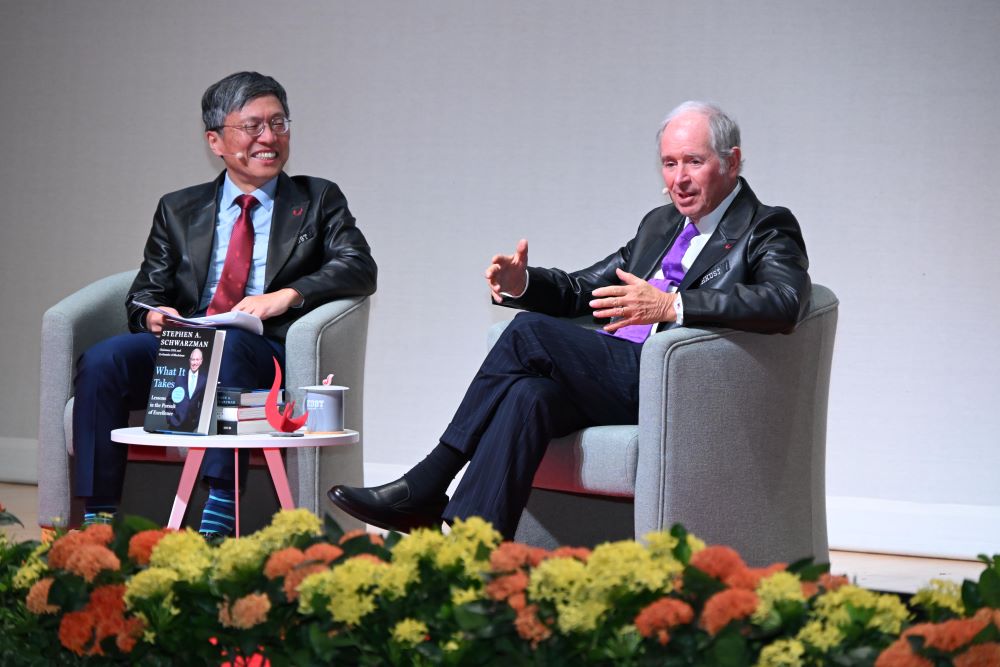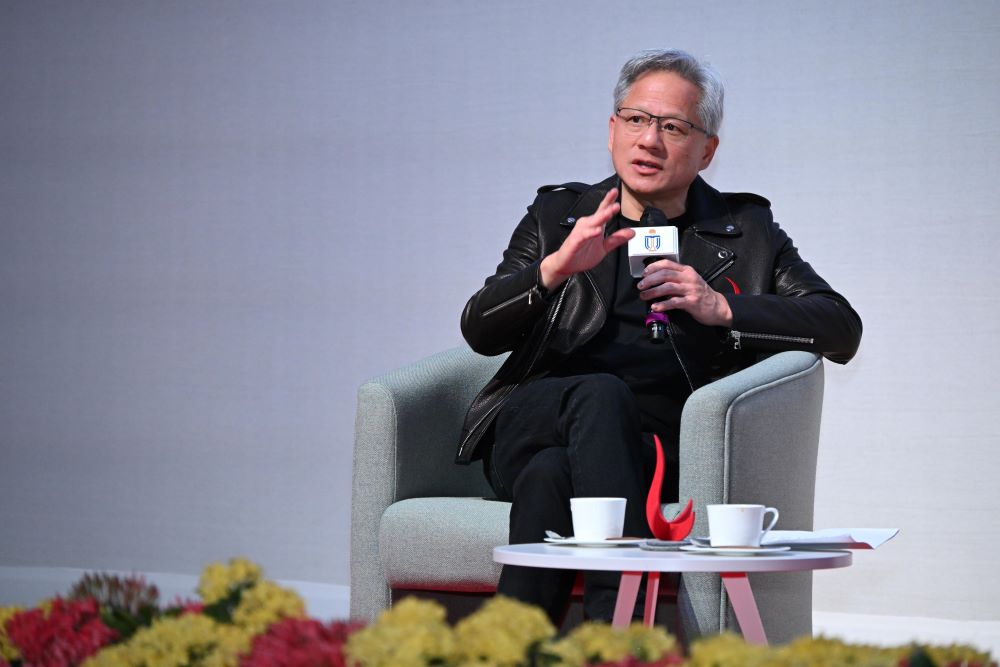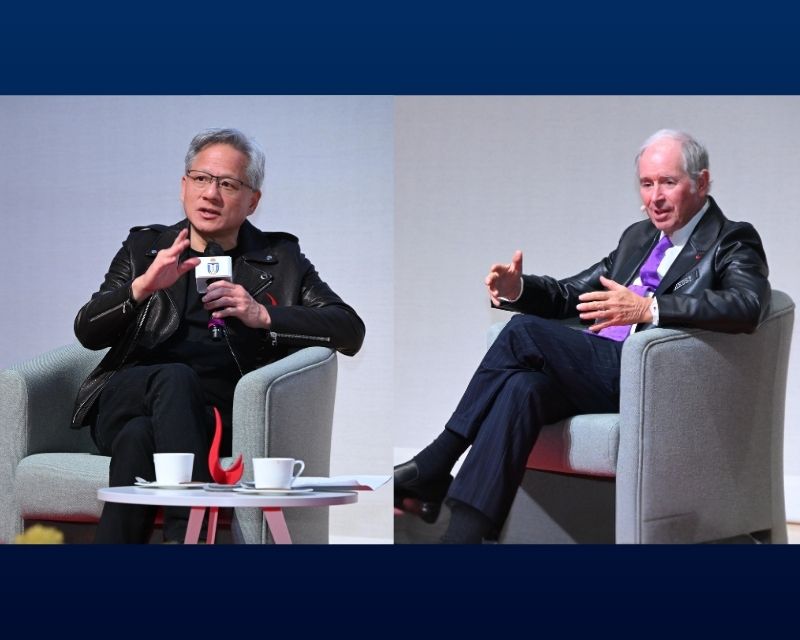Speed, listening to the front-line, hiring ‘10s’, solving other people’s problems—and an Honorary Doctorate from HKUST: These are five things Nvidia Founder, Chairman and CEO Jensen Huang and Blackstone Co-Founder, Chairman, and CEO Stephen Schwarzman have in common.
Lessons learned and implications for MBA students:
At HKUST, we aim for our MBA students to learn to think like a CEO. HKUST conferred Honorary Doctorates on Jensen Huang in Nov 2024 and Stephen Schwarzman in Oct 2025. These Honorary Doctorates recognized both of them for their extraordinary accomplishments as global CEOs shaping the technology and finance industries. Dr. Huang has built Nvidia into a multi-trillion-dollar market capitalization while Dr. Schwarzman has led Blackstone’s to over one trillion dollars in assets under management. So, after watching the HKUST Fireside Chats of both leaders and learning more about their entrepreneurial careers, I was inspired to ask: “What can we learn from these two alumni of HKUST?”
Here are four lessons from their entrepreneurial journeys and management practices that MBA applicants and students can put into practice:
Act with Speed: Business executives, analysts, and scholars habitually look at revenues and costs, assets and liabilities, and other financial metrics to optimize their business. While these are critical to any business, it’s easy to overlook a harder to measure dimension: time. Yet, moving fast is often the difference between success and failure.
In Nvidia’s early days, the company survived only by betting on speed to launch the groundbreaking RIVA 128 graphics chip. By taking a risk on testing the RIVA 128 with an emulator instead of the industry standard of physical testing, Nvidia was able to secure a big customer just before running out of cash. Nvidia then used speed to establish a competitive advantage by releasing new chip models every six months, at a time when competitors were releasing new models only every 12 months. Jensen Huang captures this mentality with his exhortation for employees to act at the ‘speed of light’.[1]
Stephen Schwarzman shares a story about how moving fast got Blackstone to the starting line. After raising money for a year, in October 1987, he pushed hard to complete all the legal paperwork with his investors without delay. Blackstone signed their first group of investors on October 15, just days before the “Black Monday” stock market crash on Oct 19. Imagine what would have happened if he had procrastinated for just a couple of days! Schwarzman expresses the value of speed with his saying that “Time wounds all deals” and highlighting the risks of delay in creating problems in investments.[2]
Even though speed in business can be hard to measure, remember that speed can lead to opportunity and competitive advantage.

Listen to the front-line: Textbook leadership recommends that a CEO ask her C-level direct reports for information before making a decision. The C-level leaders ask their SVPs, who ask their VPs, who ask their directors, and so on. In theory, this ensures that information is rigorously evaluated and synthesized before the CEO decides. However, this approach creates time delays as information is passed from one person to another. This is compounded with the risks that the information becomes watered down or distorted before the CEO hears it. To counter this and to act with speed, both Huang and Schwarzman actively seek input directly from the front-line.
Schwarzman, for example, emphasizes the importance of listening to even the most junior investment analyst working on a deal. Early in Blackstone’s history and after losing money on a deal because he only sought the views of senior colleagues, Schwarzman changed his approach. He writes “If I had detailed questions, I would call the most junior person, the one working the spreadsheets and closest to the numbers… Breaking through the hierarchy would allow me to get to know the junior people at the firm and get a different read. The risk may not be obvious on paper, but it came through in the analyst’s tone of voice when I asked them, “Just walk me through this deal from your perspective.” Schwarzman also insightfully clarifies that it’s not just about numbers or data but about sensing the underlying thoughts and emotions of the junior analysts that makes this technique so valuable to him.[3]
Huang, at Nvidia, is also known for breaking through the hierarchy. In addition to asking colleagues questions in the hallways, he asks employees at Nvidia to send “Top 5” emails every week summarizing their priorities. Huang reads hundreds of these emails throughout the week and is reputed to do a marathon email reading session on Sunday evenings over a glass of scotch. This practice has allowed him to catch trends as they emerge and may have been a decisive factor behind Nvidia’s early lead in developing the AI market.[4]
So, it’s about moving fast. But, in order to move fast, a CEO needs to stay connected with reality, make sense of emerging trends as they happen, and understand what front-line colleagues are seeing.
Hire ‘10s’: Despite – or perhaps because—they are both enormously talented individuals, both Schwarzman and Huang are vocal about hiring the right talent. Building trillion-dollar businesses requires more than a single talented CEO.
Schwarzman popularized the term ‘hiring 10s’ – people who are not simply good at their job but also entrepreneurial and able to innovate. ‘10s’ are people who think in new ways and can initiate growth of a business in new directions. A classic example is Schwarzman hiring Larry Fink in 1988. Larry founded and grew a business that eventually separated from Blackstone and became another trillion-dollar firm: BlackRock. During Schwarzman’s fireside chat at HKUST, he explained his intuition behind identifying 10s. His view is that exceptionally talented people know the other exceptionally talented people in their field: 10s know 10s. He also emphasized that reputation, especially for those over the age of 40, counts for everything and much more than an interview when hiring.[5] Huang, similarly, also notes that references are more important than interviews.[6] When looking for top talent, reputation matters.

During its growth, Nvidia has aggressively hired top engineers away from competitors. An example of the “hire 10s” mentality at Nvidia is illustrated by the company’s track record of hiring chief architects away from other competitors. As described in The Nvidia Way, by Tae Kim, most of Nvidia’s competitors would only have one or two architects – the crucial talent designing overall systems. Nvidia, however, had 20 architects in 2024. Tae Kim writes “Nvidia employees were impressed by how the company was able to poach and retain so many accomplished architects, who are known for their egos.”[7] Hiring and retaining ‘10s’ is never easy, but it is a key unlock to expand businesses beyond normal limits.
Solve other people’s problems: CEOs have the unique responsibility to define the mission for their business. Both Schwarzman and Huang recognize the importance of being ‘other-centered’ instead of ‘self-centered’ in their approach to business. They try to help solve other people’s problems.
Schwarzman thinks about this as being “a friend of the situation.” During his HKUST fireside chat, he was asked how he approaches challenging situations between and among people. He described his process “You try and think about everyone's point of view on a problem…. What's on [their] mind? What are [they] trying to achieve? And why aren't [they] doing it? And how do we solve that problem?... Everybody in a drama has their own stuff and you just need to be them. Make pretend you're them. How do you solve their problem?”[8] Or as he has explained elsewhere: “There is nothing more interesting to people than their own problems. Think about what others are dealing with, and try to come up with ideas to help them.”[9]
Huang also stressed this during his HKUST fireside chat, saying: “One fundamental idea: Don’t do it for yourself, do it for everyone else. Leaders are fundamentally trusted when every single decision that is made is in the interest of the mission. It’s in the interest of others. It’s in the interest of other people’s success.”[10]
By applying these four principles, Huang and Schwarzman have not been stereotypical corporate leaders; instead, they have pioneered new opportunities, such as Blackstone’s global expansion and entry into residential real estate, and Nvidia’s jump from video game graphics to artificial intelligence. They have reshaped their industries, and, along the way, built Trillion-dollar businesses.
Implications for MBA students
Students can take advantage of HKUST’s MBA program to develop these four leadership practices.
“Act with speed” by seizing every learning and networking opportunity that you see in the program. Get comfortable with making decisions without all the information by envisioning yourself as the protagonist in our lively case study discussions.
Learn to “Listen to the front-line” by getting to know your classmates and appreciating the diversity of views and perspectives among people. Build the habit of asking good questions and listening with empathy.
“Meet 10s and become a 10” through our HKUST community. By engaging with other high performing and high energy students and alumni, by learning from world-class faculty and guest speakers, and by embracing HKUST’s environment of innovation, you’ll learn to spot ‘10s’ while also putting yourself on the path to becoming a ‘10’.
Build the habit of “solving other people’s problems.” Read about the business leaders featured in our case studies, listen to our guest speakers from industry, get to know your classmates. Use the program to learn to understand the goals and challenges other people face, and ways you can help solve them. Commit yourself to an MBA community that actively supports each other.
While you may not set out to build a trillion-dollar business, if you want to reach your personal full potential, adopting these four principles can help you become a ‘10’-- or the person who ‘hires 10s’.
[1] For Nvidia’s history and Jensen’s leadership style, The Thinking Machine: Jensen Huang, Nvidia, and the World’s Most Coveted Microchip, by Stephen Witt and The Nvidia Way: Jensen Huang and the Making of a Tech Giant by Tae Kim are well written and researched accounts featuring in-depth interviews with Jensen and many of his colleagues. For these examples of speed, see Witt pp41-44 and p69 and Kim pp66-74 and pp93-94.
[2] Stephen Schwarzman’s What It Takes: Lessons in the Pursuit of Excellence shares many stories describing his leadership principles. See p123-124 for the “black Monday” story.
[3] Schwarzman, p 152-153
[4] The Nvidia Way, Kim, pp168-169 provides interesting anecdotes describing this.
[5] “Lessons from a Life of Leadership, Entrepreneurship, and Giving Back” Fireside chat at HKUST with Stephen Schwarzman and Harry Shum (Oct 18, 2025) (https://www.youtube.com/watch?v=wpLoVXfPR7s) (accessed Nov 6, 2025)
[6] How Nvidia CEO Jensen Huang Interviews, Hires New Employees (https://www.entrepreneur.com/business-news/how-nvidia-ceo-jensen-huang-interviews-hires-new-employees/481122 (accessed Nov 6, 2025)
[7] Kim, pp236-237 shares details on hiring architects. Witt, p77, illustrates another early example of Huang’s hiring standards.
[8] “Lessons from a Life of Leadership, Entrepreneurship, and Giving Back” Fireside chat at HKUST
[9] Schwarzman, p351
[10] “Technology, Leadership, and Entrepreneurship” Fireside chat at HKUST with Jensen Huang and Harry Shum (Nov 23, 2024). https://www.youtube.com/watch?v=h-66Jds6lgU (accessed Nov 7, 2025)
Official HKUST Honorary Doctorate Citation
Mr. Stephen A. SCHWARZMAN (Doctor of Business Administration honoris causa)
Dr. Jensen Huang (Doctor of Engineering honoris causa)
For those interested in exploring these themes further, check out the books below.
The Thinking Machine: Jensen Huang, Nvidia, and the World's Most Coveted Microchip by Stephen Witt
The Nvidia Way: Jensen Huang and the Making of a Tech Giant by Tae Kim
What It Takes: Lessons in the Pursuit of Excellence by Stephen A. Schwarzman

